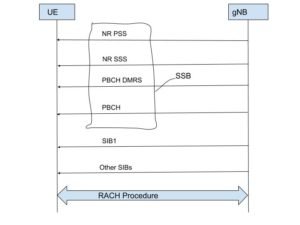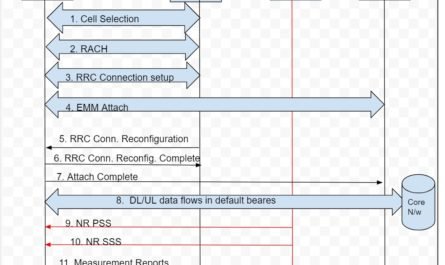
Initial Access and cell selection in 5G NR Network
Initial access and the cell selection in 5g NR is the 1st procedure when you switch on the device. So, this allows the Mobile device to find a cell to camp on. And it receives necessary system information which help UE to request a connection through Random Access channel.
Basic NR initial access is somewhat similar to LTE. In 5G NR there is a concept of SSB block. This SSB block consists of PSS, SSS and PBCH. All these three signal the we call SSB is sent together. These signals are sent periodically with default periodicity 20 ms.
Read about 5G NR physical layer. 5G Physical layer Overview: Numerologies, waveform and frame structure.
Cell Selection procedure
- PSS (primary synchronization signal): UE uses PSS to achieve slot and subframe synchronization both in time and frequency domain. Also UE uses PSS sequence to identify physical layer cell identity out of 3 physical layer identities within a physical layer cell identity group.
- SSS (Secondary synchronization signal): UE uses SSS to achieve frame synchronization both in time and frequency domain. Also UE uses SSS sequence to identify one physical layer cell identity group out of 335 physical layer cell identity group.
- UE uses PSS and SSS to identify the physical layer cell Identity (PCI).
- PBCH: Physical broadcast channel(PBCH) is transmitted together with PSS/SSS. The PBCH carries a very basic system information and it also carries an indication about where the remaining broadcast system information is transmitted.
- In 5G NR PSS, SSS and PBCH are transmitted in a single block. This block is called SSB.
- By default this SSB block is transmitted every 20 milliseconds.
- An SSB is mapped to 4 OFDM symbols in time domain and 240 sub carries which 20 RBs in frequency domain.
- PBCH DMRS: This acts as a reference signal for decoding PBCH.
- In LTE we have CSRS (cell specific reference signal) which is used to decode PBCH. In 5G NR, there is no CSRS. So we have special dedicated PBCH DMRS reference signal to decode PBCH.
- The main purpose of SSB is to carry MIB (Master Information Block).
-
MIB contains information like
- Cell Barred status.
- SIB1 information.
- Sytem frame number etc.
Once UE reads MIB and SIBs, it decides whether to camp on the cell or not. If everything is OK, then UE will complete the cell selection procedure and move to the next step which is RACH (Random access procedure). RACH will be discussed later.
To know more about 5g reference signals visit this link. 5G NR Reference Signals PTRS, DMRS, CSI-RS, SRS.
What is the difference between lte cell selection and 5G NR cell selection?
- In LTE we have CSR (Cell Specific Reference signals) while in 5G NR we have special dedicated PBCH DMRS to decode PBCH.
- In case of lte PSS, SSS and PBCH are located at the center of the carrier whereas 5G support sparse frequency raster for SS block as a result SS block will not be located at the center of the NR carrier.
- PSS, SSS and PBCH are transmitted every 5 milliseconds in LTE but in case of 5G SS block is transmitted every 20 milliseconds.
Click here for 5G NR ENDC (Dual Connectivity) end to end attach Call flow.




Good explanation .. thanks
I have a doubt that if PBCH DMRS is part of ssb??
yes, PBCH DMRS is part of ssb